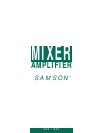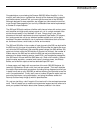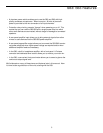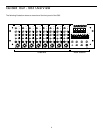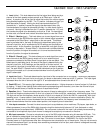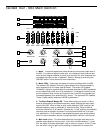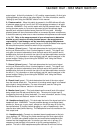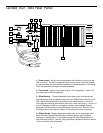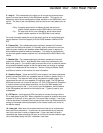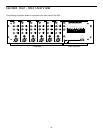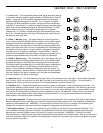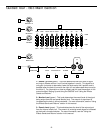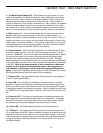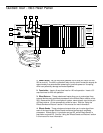
S83/S63 Features
The Samson S83/S63 utilizes state-of-the-art technology in integrated
mixer/amplifier design. Here are some of its main features:
• Standard 19” rack-mount design (taking just four rack spaces) allows the
S83 and S63 to be easily integrated into any setup.
• Multiple channels (eight in the S83; six in the S63) and mic and line inputs
for each channel allow you to blend together a variety of source signals,
including dynamic or condenser microphones, keyboards, CD/tape players,
etc. Standard XLR mic connectors (for microphone inputs) and electronical-
ly
balanced 1/4” jacks (for line-level inputs) are provided for each channel;
in addition, there is a dedicated CD/Tape input that provides dual phono
(RCA) jacks.
• Power to spare—both units include a clean, high-quality amplifier, delivering
300 watts (in the case of the S83) or 210 watts (in the case of the S63) into
four ohms. Any standard speaker cabinets (two, four, eight, or sixteen
ohms) can be connected to the rear-panel 1/4” speaker output jacks.
• A built-in three-spring reverb unit allows you to add reverberation effects to
your vocals or instruments without having to use an expensive external
signal processor. A front-panel reverb master volume control allows you to
precisely define the amount of reverb to be added to the signal.
• Each channel provides independent equalization controls (four-band in the
S83; three-band in the S63), enabling you to shape the sound of your input
signal sources. In addition, a ten-band graphic master equalizer allows you
to “tune” the output of the S83/S63 to the particular room environment you
are in. This can be particularly useful for eliminating ringing or feedback
problems.
• In the S83, Peak LEDs for each channel show you at a glance when an
input signal is on the verge of overloading. In the S63, a master Peak LED
shows you at a glance when the internal amplifier is overloading. In both
units, other front-panel LEDs show the current status of the amplifier’s pro-
tection relay circuitry and whether or not phantom power is being applied.
• Independent input Trim controls for each channel that allows you to precise-
ly set the correct input gain.
• Two Effects sends per channel (one pre-fade and the other post-fade) allow
you to route multiple signals to the internal reverb unit or to external signal
processors. The pre-fade send (Effects send 1) can be used as a Monitor
control, allowing you to set up an onstage monitor mix that is independent of
the main house mix. A separate Monitor level control is provided on the
front panel.
• In the S83, four Effects returns give you the ability to blend in the return sig-
nal from external signal processors or other line-level devices without having
to utilize input channels. Two front-panel Effects return level controls (one
for Effects returns 1-2 and the other for Effects returns 3-4) allow you to
bring in stereo signals, which are then automatically mixed together in mono.
In the S63, two Effects returns are provided, with a single front-panel control
for the two.
2



